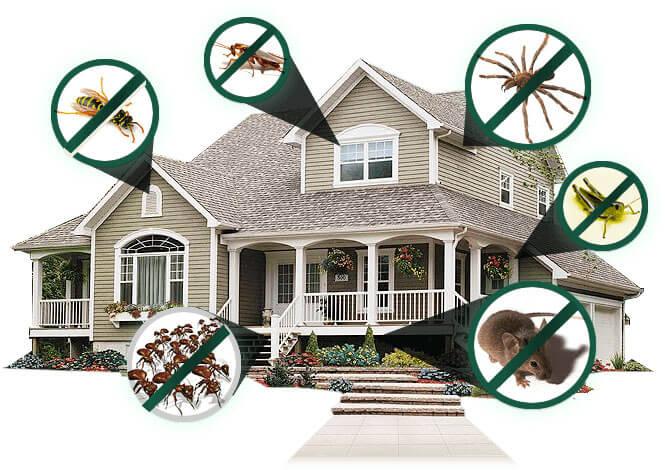Top Quality A1 Pest Control Services Charlotte - Shield Your Home
Bed Insect Treatment Malfunction: Contrasting Chemical Vs. Non-Chemical Solutions
In the realm of insect control, specifically when dealing with the consistent concern of bed bugs, the option in between chemical and non-chemical treatment options can be a pivotal one. Both techniques supply distinct advantages and downsides, influencing variables such as effectiveness, security factors to consider, and total price. By checking out the nuanced information of each technique, a more clear understanding of which course to seek in attending to a bed pest problem can be obtained.
Performance of Chemical Treatments
Chemical therapies for bed pest invasions have actually been commonly acknowledged for their powerful and quick effectiveness in getting rid of these bugs. When considering the effectiveness of chemical therapies, it is crucial to understand that they can give a fast and comprehensive service to a bed bug problem.
In addition, chemical treatments have the advantage of using recurring effects, meaning that they can remain to remove bed pests also after the first application. This recurring action is specifically valuable in combating any kind of prospective re-infestations. In addition, the fast action of chemical treatments can bring alleviation to people encountering serious bed bug invasions, enabling them to gain back control of their home rapidly.
Safety Concerns With Chemical Solutions
One crucial aspect that needs careful factor to consider when making use of chemical solutions for bed insect therapy is ensuring the safety of residents and the environment. While chemical therapies can be efficient in eliminating bed bugs, they may pose risks if not taken care of appropriately. Among the primary safety and security interest in chemical solutions is the possible harm they can trigger to human health. Exposure to particular chemicals used in bed insect treatments can lead to breathing problems, skin inflammation, or other adverse reactions, particularly in people with pre-existing conditions or level of sensitivities. In addition, incorrect application or dose of chemical pesticides can cause toxic deposits remaining in the cured area, posing long-lasting health threats to passengers.
Moreover, the ecological impact of chemical options is another considerable factor to consider. Some chemicals used in bed bug treatments might be harmful to valuable insects, wild animals, and environments if they seep right into the dirt or water systems. It is necessary to use chemical therapies judiciously, complying with security guidelines, and considering less hazardous choices to minimize these risks and ensure the efficient and secure monitoring of bed bug invasions.
Advantages of Non-Chemical Approaches
Thinking about the prospective safety issues and environmental effect associated with chemical options for bed pest treatment, checking out non-chemical techniques presents an encouraging choice with several distinctive benefits. Non-chemical therapies are eco pleasant, as they do not contribute to air or water pollution, making them a helpful resources lasting option for pest control.
Additionally, non-chemical services can be effective in targeting bed insects, consisting of hard-to-reach locations where chemical therapies might not pass through - A1 bed bug exterminator charlotte. Methods such as warm treatment, vacuuming, heavy steam cleansing, and cushion coverings offer thorough elimination without the use of damaging chemicals.
Limitations of Non-Chemical Treatments

Furthermore, non-chemical treatments typically require multiple applications to attain successful obliteration. This can be taxing and may not constantly ensure complete removal of all bed insects and their eggs, especially in covert or hard-to-reach locations.
In addition, the success of non-chemical treatments greatly relies upon correct implementation and thoroughness, which can be testing for individuals without professional expertise. Inadequate application of non-chemical methods may lead to incomplete obliteration, leading to persistent invasions and the requirement for added therapies.
For that reason, while non-chemical treatments have their benefits, it is essential to recognize these limitations and consider them when identifying the most effective method for managing bed bug infestations.
Price Contrast: Chemical Vs. Non-Chemical Options
Provided the restrictions associated with non-chemical treatments, a vital element to assess in the context of bed bug management is Going Here the price contrast between chemical and non-chemical choices. Chemical treatments usually include the application of pesticides by specialists, which can range from $250 to $900 per room, depending upon the seriousness of the problem and the size of the area to be dealt with. In comparison, non-chemical treatments like warm treatment or steam can be much more pricey, with prices ranging from $1,000 to $6,000 for a whole home. While the initial price of chemical therapies may appear lower, numerous treatments might be needed to fully remove the problem, possibly increasing the general cost. On the other hand, non-chemical options may provide a much more green and sustainable option, although they can be cost-prohibitive for some individuals. Eventually, when thinking about the price of bed bug therapy alternatives, it is essential to weigh the in advance expenses versus the effectiveness and lasting sustainability of the chosen approach.
Verdict

Considering the possible safety issues and environmental effect linked with chemical remedies for bed pest treatment, discovering non-chemical methods presents a promising alternative with a number of unique advantages.Provided the constraints linked with non-chemical therapies, a vital element to review in the context of bed bug administration is the expense contrast in between chemical and non-chemical choices. In comparison, non-chemical therapies like warmth therapy or steam can be much more costly, with expenses varying from $1,000 to $6,000 for a whole home. While the first price of chemical therapies may seem lower, several therapies might be called for to fully get rid of the problem, potentially boosting the overall cost.In conclusion, when comparing chemical find out this here and non-chemical bed insect therapy options, it is essential to consider performance, safety and security, advantages, restrictions, and cost.